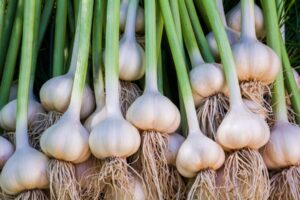Garlic Cultivation in South Africa
In the rich tapestry of South African agriculture, garlic stands as a crop of notable importance, offering both culinary and medicinal value. Its cultivation has been embraced in various regions of the country, adapting to diverse climates and soils. This detailed guide delves into the intricacies of growing garlic in South Africa, examining aspects like yielding, cultivation practices, irrigation, fertigation, pest control, harvesting, and storage across different provinces.

Garlic, or Allium sativum, is a hardy plant that prospers in a range of climatic conditions, making it well-suited for South African soil. Cultivation begins with the selection of quality seed cloves, ideally from disease-free, high-yielding varieties. Each province’s climate and soil type influence the choice of variety.
Yielding Potential
Garlic’s yield in South Africa varies based on agricultural practices and environmental factors. On average, well-maintained fields can yield between 4 to 6 tons per hectare. Provinces with cooler winters, like the Free State and Eastern Cape, often see higher yields due to the crop’s preference for chillier germination periods.
Cultivation Techniques
Garlic requires well-drained soil with a pH between 6.0 and 7.0. Preparation involves deep plowing and thorough mixing of organic matter. The planting season typically spans from March to May, depending on the region’s climate.
Irrigation Requirements
Garlic demands consistent and moderate watering. Drip irrigation is most effective, providing adequate moisture while conserving water – a crucial consideration in drier provinces like the Western and Northern Cape.

Fertigation Requirements
Balanced fertilization is critical for garlic. A combination of nitrogen, phosphorus, and potassium, along with essential micronutrients, ensures robust growth. Soil testing helps tailor the fertigation needs to specific provincial soil conditions.
Pest and Disease Control
Garlic is susceptible to pests like onion thrips and diseases such as white rot. Integrated pest management, combining cultural practices, biological control, and minimal chemical intervention, is advisable. Each province’s specific pest and disease challenges require targeted strategies.
Harvesting and Storage
Harvesting garlic at the right maturity stage, usually when the lower leaves turn brown, is crucial for quality. In South Africa, this typically occurs from October to December. Post-harvest, curing in a dry, ventilated area is essential for long-term storage. The dry climates of the Western Cape and Northern Cape are advantageous for natural curing processes.
Provincial Overview of Garlic Cultivation
Western Cape
The Western Cape’s Mediterranean climate necessitates efficient irrigation management. Water scarcity in this region makes water-saving techniques like mulching and drip irrigation vital.
Eastern Cape
The cooler temperatures in the Eastern Cape are conducive to garlic farming. However, attention to frost protection is crucial during the colder months.
KwaZulu-Natal
KwaZulu-Natal’s humid climate requires vigilant fungal disease management. Adequate spacing and air circulation are essential to mitigate disease risks.
Free State
This province’s cold winters are beneficial for garlic bulb development. However, proper irrigation during the dry season is crucial to ensure steady growth.
Northern Cape
The arid conditions of the Northern Cape demand innovative water management solutions, with a focus on water efficiency and conservation.
North West
Similar to the Northern Cape, water management is critical. Additionally, managing soil fertility is vital due to the region’s variable soil types.
Gauteng
Urban and small-scale garlic farming is emerging in Gauteng. Adapting cultivation techniques to smaller plots and managing urban environmental stressors are key.
Limpopo
Limpopo’s warm climate necessitates careful pest management, particularly for controlling thrips, which thrive in warmer temperatures.
Mpumalanga
Mpumalanga’s humid conditions pose a challenge for disease control. Adequate crop rotation and field hygiene can help mitigate these risks.
Conclusion

Garlic cultivation in South Africa offers a promising avenue for agricultural development, with each province presenting unique opportunities and challenges. By focusing on region-specific cultivation techniques, irrigation and fertigation strategies, and pest and disease control, farmers can maximize yields and quality.
As the demand for garlic continues to rise, both for its culinary and health benefits, South African farmers are well-positioned to contribute significantly to both the local and international markets. This guide serves as a starting point for those embarking on the rewarding journey of garlic farming in the diverse climatic regions of South Africa.

